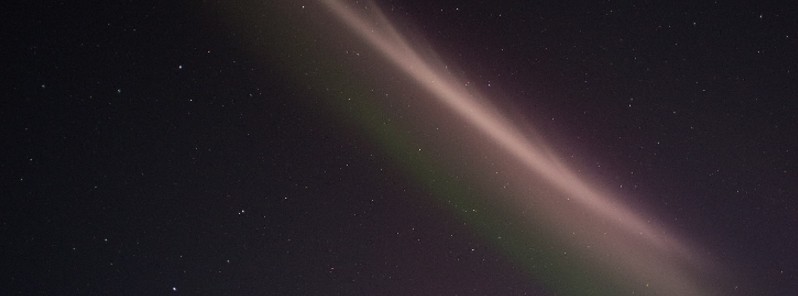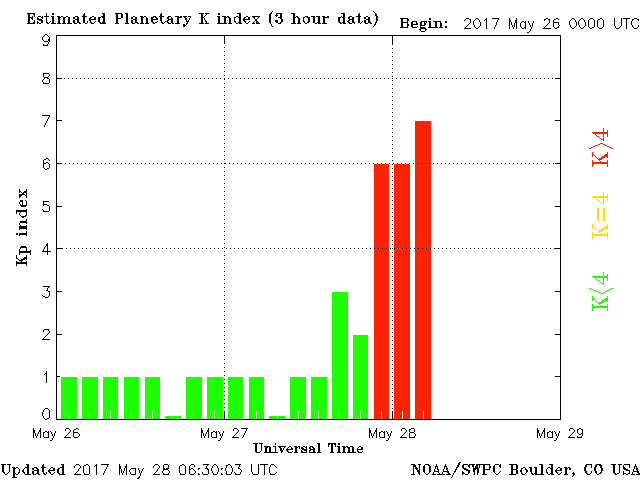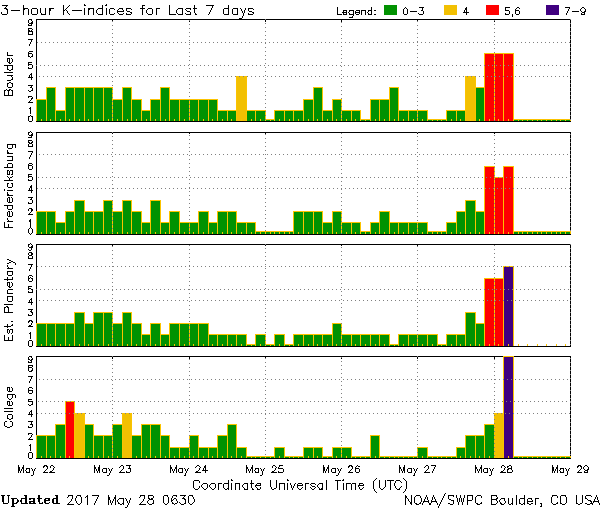CME impact sparks G3 – Strong geomagnetic storm

A coronal mass ejection (CME) produced during the early UTC hours of May 23, 2017 hit Earth's magnetic field at 15:36 UTC on May 27, more than 24 hours after it was expected. Although the solar wind speed is relatively slow, the embedded magnetic field had a prolonged period of southward Bz that managed to spark G3 – Strong geomagnetic storm.
G3 – Strong geomagnetic storm (K-index of 7) threshold was reached at 04:19 UTC. Under G3 conditions, the area of impact is primarily poleward of 50 degrees Geomagnetic Latitude. Power system voltage irregularities are possible and false alarms may be triggered on some protection devices. Spacecraft systems may experience surface charging and increased drag on low Earth-orbit satellites and orientation problems may occur. Intermittent satellite navigation (GPS) problems, including loss-of-lock and increased range error may occur. HF (high frequency) radio may be intermittent, aurora may be seen as low as Pennsylvania to Iowa to Oregon.
Read more: CME headed toward Earth, impact expected around 12:00 UTC on May 26


Quiet to unsettled levels are expected after 12:00 UTC on May 28 through May 29 as CME effects diminish. Generally, quiet conditions are expected on May 30 with the return of a nominal solar wind regime.
SWPC alerts
Space Weather Message Code: SUMSUD
Serial Number: 220
Issue Time: 2017 May 27 1546 UTC
SUMMARY: Geomagnetic Sudden Impulse
Observed: 2017 May 27 1536 UTC
Deviation: 19 nT
Station: BOU
***
Space Weather Message Code: ALTK04
Serial Number: 1979
Issue Time: 2017 May 27 2202 UTC
ALERT: Geomagnetic K-index of 4
Threshold Reached: 2017 May 27 2202 UTC
Synoptic Period: 2100-2400 UTC
Active Warning: Yes
Potential Impacts: Area of impact primarily poleward of 65 degrees Geomagnetic Latitude.
Induced Currents – Weak power grid fluctuations can occur.
Aurora – Aurora may be visible at high latitudes such as Canada and Alaska.
***
Space Weather Message Code: ALTK05
Serial Number: 1111
Issue Time: 2017 May 27 2255 UTC
ALERT: Geomagnetic K-index of 5
Threshold Reached: 2017 May27 2255 UTC
Synoptic Period: 2100-2400 UTC
Active Warning: Yes
NOAA Scale: G1 – Minor
Potential Impacts: Area of impact primarily poleward of 60 degrees Geomagnetic Latitude.
Induced Currents – Weak power grid fluctuations can occur.
Spacecraft – Minor impact on satellite operations possible.
Aurora – Aurora may be visible at high latitudes, i.e., northern tier of the U.S. such as northern Michigan and Maine.
***
Space Weather Message Code: ALTK06
Serial Number: 432
Issue Time: 2017 May 27 2323 UTC
ALERT: Geomagnetic K-index of 6
Threshold Reached: 2017 May27 2322 UTC
Synoptic Period: 2100-2400 UTC
Active Warning: Yes
NOAA Scale: G2 – Moderate
Potential Impacts: Area of impact primarily poleward of 55 degrees Geomagnetic Latitude.
Induced Currents – Power grid fluctuations can occur. High-latitude power systems may experience voltage alarms.
Spacecraft – Satellite orientation irregularities may occur; increased drag on low Earth-orbit satellites is possible.
Radio – HF (high frequency) radio propagation can fade at higher latitudes.
Aurora – Aurora may be seen as low as New York to Wisconsin to Washington state.
***
Space Weather Message Code: ALTK07
Serial Number: 105
Issue Time: 2017 May 28 0420 UTC
ALERT: Geomagnetic K-index of 7
Threshold Reached: 2017 May 28 0419 UTC
Synoptic Period: 0300-0600 UTC
Active Warning: Yes
NOAA Scale: G3 – Strong
NOAA Space Weather Scale descriptions can be found at
www.swpc.noaa.gov/noaa-scales-explanation
Potential Impacts: Area of impact primarily poleward of 50 degrees Geomagnetic Latitude.
Induced Currents – Power system voltage irregularities possible, false alarms may be triggered on some protection devices.
Spacecraft – Systems may experience surface charging; increased drag on low Earth-orbit satellites and orientation problems may occur.
Navigation – Intermittent satellite navigation (GPS) problems, including loss-of-lock and increased range error may occur.
Radio – HF (high frequency) radio may be intermittent.
Aurora – Aurora may be seen as low as Pennsylvania to Iowa to Oregon.
***
Space Weather Message Code: ALTK05
Serial Number: 1114
Issue Time: 2017 May 28 0719 UTC
ALERT: Geomagnetic K-index of 5
Threshold Reached: 2017 May 28 0718 UTC
Synoptic Period: 0600-0900 UTC
Active Warning: Yes
NOAA Scale: G1 – Minor
Potential Impacts: Area of impact primarily poleward of 60 degrees Geomagnetic Latitude.
Induced Currents – Weak power grid fluctuations can occur.
Spacecraft – Minor impact on satellite operations possible.
Aurora – Aurora may be visible at high latitudes, i.e., northern tier of the U.S. such as northern Michigan and Maine.
***
Space Weather Message Code: ALTK06
Serial Number: 435
Issue Time: 2017 May 28 0824 UTC
ALERT: Geomagnetic K-index of 6
Threshold Reached: 2017 May 28 0823 UTC
Synoptic Period: 0600-0900 UTC
Active Warning: Yes
NOAA Scale: G2 – Moderate
Potential Impacts: Area of impact primarily poleward of 55 degrees Geomagnetic Latitude.
Induced Currents – Power grid fluctuations can occur. High-latitude power systems may experience voltage alarms.
Spacecraft – Satellite orientation irregularities may occur; increased drag on low Earth-orbit satellites is possible.
Radio – HF (high frequency) radio propagation can fade at higher latitudes.
Aurora – Aurora may be seen as low as New York to Wisconsin to Washington state.
Featured image: Steve captured by Joseph Shaw on May 27, 2017 at Bozeman, Montanam USA (via SpaceWeather.com)

Commenting rules and guidelines
We value the thoughts and opinions of our readers and welcome healthy discussions on our website. In order to maintain a respectful and positive community, we ask that all commenters follow these rules.